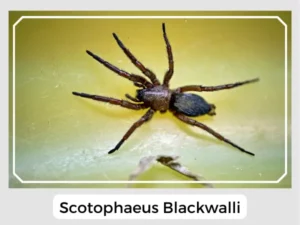The Scotophaeus blackwalli, commonly known as the Mouse spider (not to be confused with the Australian Mouse spider), is a fascinating creature that captivates the interest of both arachnologists and the general public. Despite its common name, this species is far from the daunting presence its Australian namesake suggests, residing mostly in the shadows of our homes and gardens. This introductory guide aims to provide insights into its physical characteristics, behavior, and much more in an easy-to-understand manner.

The female Scotophaeus blackwalli lays her eggs in a silk cocoon, which she fiercely guards until they hatch. The cocoon is usually hidden in secluded areas, ensuring protection from predators.
Upon hatching, the spiderlings are independent and disperse quickly. They resemble miniature versions of the adults but are lighter in color. These juveniles undergo several molts before reaching adulthood.
Unlike many other spiders, Scotophaeus blackwalli does not construct a web for catching prey. Instead, it is a hunting spider, relying on its agility and stealth to capture its meals.
Yes, like most spiders, Scotophaeus blackwalli has venom. However, it is harmless to humans, used primarily to subdue its prey rather than for defense against larger threats.
While they can bite, instances are extremely rare and usually occur only when they feel threatened and have no escape route. The bite is generally harmless to humans, causing minimal discomfort.
Natural Predator: This spider serves as a natural pest controller, feeding on common household insects and thus playing a crucial role in maintaining ecological balance.
Prey-Predator Dynamics: Scotophaeus blackwalli relies on its stealth and agility to ambush prey, primarily feeding on small insects and other arthropods, showcasing a fascinating aspect of the prey-predator dynamics in urban and natural ecosystems.
Relationship with Humans: Mouse spiders are generally reclusive, preferring to avoid human interaction. Their presence is often unnoticed, contributing silently to controlling pest populations around homes.
| Distribution | Widely found across Europe and North America. |
| Habitat | Prefers dark, secluded areas such as under rocks, in leaf litter, or within human dwellings. |
| Diet | Carnivorous, mainly feeding on small insects and arthropods. |
| Lifespan | Approximately 2 years. |
| Predators | Birds, larger spiders, and other predatory insects. |
| IUCN Conservation Status | Not evaluated, but considered to be of least concern due to its wide distribution and adaptability. |
In conclusion, the Scotophaeus blackwalli, or mouse spider, is a remarkable creature that plays a vital role in our ecosystems, often without our knowledge. By understanding more about these spiders, we can appreciate their contribution to our environment and coexist peacefully. Their discreet nature and pest control abilities make them unsung heroes of the arachnid world, deserving of our respect and admiration rather than fear.
The Scotophaeus blackwalli, commonly known as the Mouse spider (not to be confused with the Australian Mouse spider), is a fascinating creature that captivates the interest of both arachnologists and the general public. Despite its common name, this species is far from the daunting presence its Australian namesake suggests, residing mostly in the shadows of our homes and gardens. This introductory guide aims to provide insights into its physical characteristics, behavior, and much more in an easy-to-understand manner.

The female Scotophaeus blackwalli lays her eggs in a silk cocoon, which she fiercely guards until they hatch. The cocoon is usually hidden in secluded areas, ensuring protection from predators.
Upon hatching, the spiderlings are independent and disperse quickly. They resemble miniature versions of the adults but are lighter in color. These juveniles undergo several molts before reaching adulthood.
Unlike many other spiders, Scotophaeus blackwalli does not construct a web for catching prey. Instead, it is a hunting spider, relying on its agility and stealth to capture its meals.
Yes, like most spiders, Scotophaeus blackwalli has venom. However, it is harmless to humans, used primarily to subdue its prey rather than for defense against larger threats.
While they can bite, instances are extremely rare and usually occur only when they feel threatened and have no escape route. The bite is generally harmless to humans, causing minimal discomfort.
Natural Predator: This spider serves as a natural pest controller, feeding on common household insects and thus playing a crucial role in maintaining ecological balance.
Prey-Predator Dynamics: Scotophaeus blackwalli relies on its stealth and agility to ambush prey, primarily feeding on small insects and other arthropods, showcasing a fascinating aspect of the prey-predator dynamics in urban and natural ecosystems.
Relationship with Humans: Mouse spiders are generally reclusive, preferring to avoid human interaction. Their presence is often unnoticed, contributing silently to controlling pest populations around homes.
| Distribution | Widely found across Europe and North America. |
| Habitat | Prefers dark, secluded areas such as under rocks, in leaf litter, or within human dwellings. |
| Diet | Carnivorous, mainly feeding on small insects and arthropods. |
| Lifespan | Approximately 2 years. |
| Predators | Birds, larger spiders, and other predatory insects. |
| IUCN Conservation Status | Not evaluated, but considered to be of least concern due to its wide distribution and adaptability. |
In conclusion, the Scotophaeus blackwalli, or mouse spider, is a remarkable creature that plays a vital role in our ecosystems, often without our knowledge. By understanding more about these spiders, we can appreciate their contribution to our environment and coexist peacefully. Their discreet nature and pest control abilities make them unsung heroes of the arachnid world, deserving of our respect and admiration rather than fear.